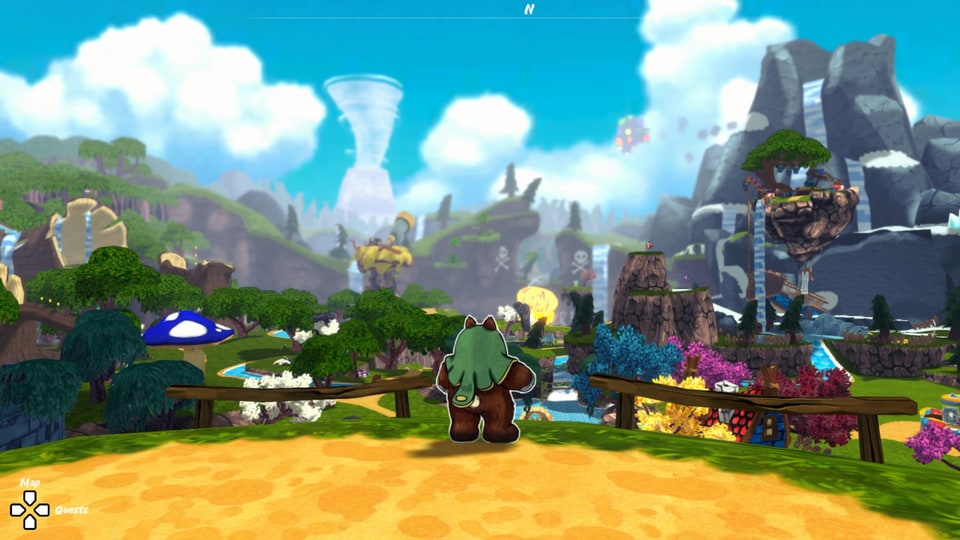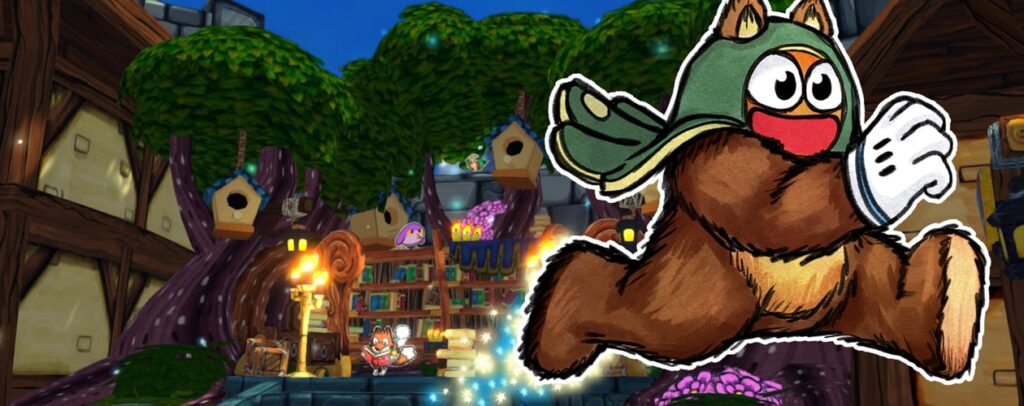Ruffy is an off-brand Ewok, a bear with a huge grin, a hidden destiny and a penchant for funky tunes. He’s also got one hell of a special ability, being able to scan things in his environment, and then transfer their texture and qualities to something else. Need to get to the top of a waterfall? How about turning the water into clinging vines to climb? Need to clear a path? Why not turn the stone into wood that you can smash apart? The swapping mechanic is at the heart of Ruffy and the Riverside, adding a heap of puzzling action to its charming 3D platforming, and it’s mostly a winning combination.
Ruffy is a bear that’s been raised by his uncle, cultivating his amazing swap ability as he grew. This seems to have been used for an illicit counterfeit art business, but let’s paper over that particular crack. When Sir Eddler arrives to take Ruffy off on an adventure, it soon becomes clear that Ruffy is the chosen one, capable of restoring the power of Riverside and fighting back against the evil Groll.
Ruffy and the Riverside is undoubtedly distinctive. It combines an N64/Dreamcast-esque polygonal platforming world with 2D hand-drawn characters and art, making it feel as though a sketch pad has come to life. It’s colourful, unique and joyful; I love it, even if there are some limitations with animations, such as how each character moves through a short window of movement when you’re talking to them.

Swapping is the key mechanic here, and Ruffy is far more of a puzzler than it is a platformer. Swapping the textures of each different substance is such a great idea, it’s hard to believe that it hasn’t been done on this scale before. The puzzles start off with simple solutions, the textures you need to swap being quite obvious, but as you progress things get increasingly trickier, forcing you to really think things through.
You can brute force your way through if you’re stuck – there does tend to be a limited number of possible textures in each area, and you can only hang onto the texture for a short amount of time, so you can’t race around the map using the same one over and over again – but a bit of careful thought will normally see you through.
This is truly Ruffy’s reason for existing, and the whole game hangs on how intriguing and clever this one mechanic is. You’ll likely be surprised by how many different ways it’s implemented, and there’s a steady trickle of dopamine as your reward for each successful section.
As you race around following the main storyline, there’s a bunch of additional challenges and puzzles to distract and obsess over, starting with the puzzle potatoes, which ask you to replicate a shape found in the environment by swapping nine tiles around. These were my favourite puzzles, if only because you have to memorise the shape in your head, and be careful not to erase a tile you’re going to need.
Besides that, there’s Etoi to find, little creatures hidden around the environment, butterflies to collect, and the shady crows who offer you riddles. Solve these, and you’ll gain access to a 2D platforming section that sees you embossed on a wall or the side of a cliff. These areas have definitely taken inspiration from a raft of Mario games, but if you’re going to copy someone’s homework, make it the smartest kid in class.
As an indie title, Ruffy does have a few rougher edges, not least a slightly unstable framerate on Nintendo Switch. That’s not entirely evened out by playing on Switch 2 either, though it’s only particularly noticeable when you’re running around at full speed in a feature-packed area. Besides that, the swapping mechanic can sometimes be very particular about which section of a texture it’s going to lock onto, and you might occasionally think that you can’t swap a texture when you can.
While I did like the suitably cheerful music that accompanies Ruffy’s adventure, you’ll find that there’s a lot of repetition, with the same musical sections returning time and time again, and each being on a fairly short loop. One of these sounds like David Bowie’s Golden Years which had me on a Apple Music-fuelled adventure of my own while I tried to work it out. If you’re interested I got there by remembering Heath Ledge dancing to it, which first had me stop off at 10 Things I Hate About You, before finally working out it was A Knight’s Tale. As far as Ruffy goes, it’s a shame if you’re the kind of player who won’t be able to tune out from the repeating sections, and it would have been nice to have more variety and longer musical compositions.
These are all minor quibbles in the scheme of things though, and Ruffy manages to smooth over most of them with its visual charm, witty dialogue and smart mechanics.
